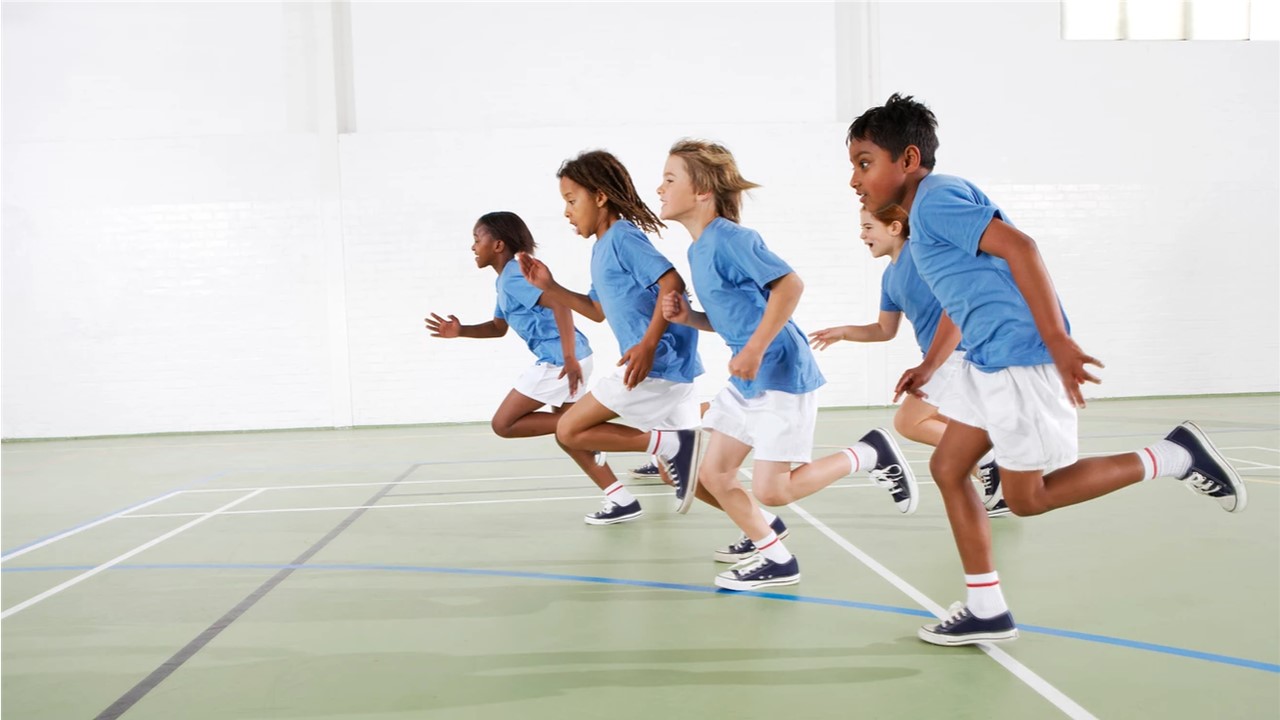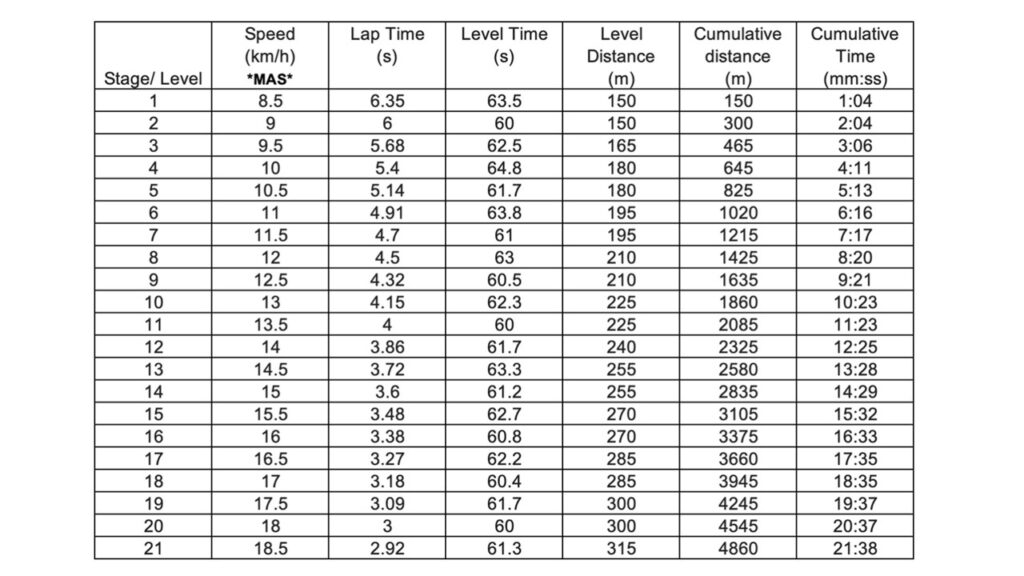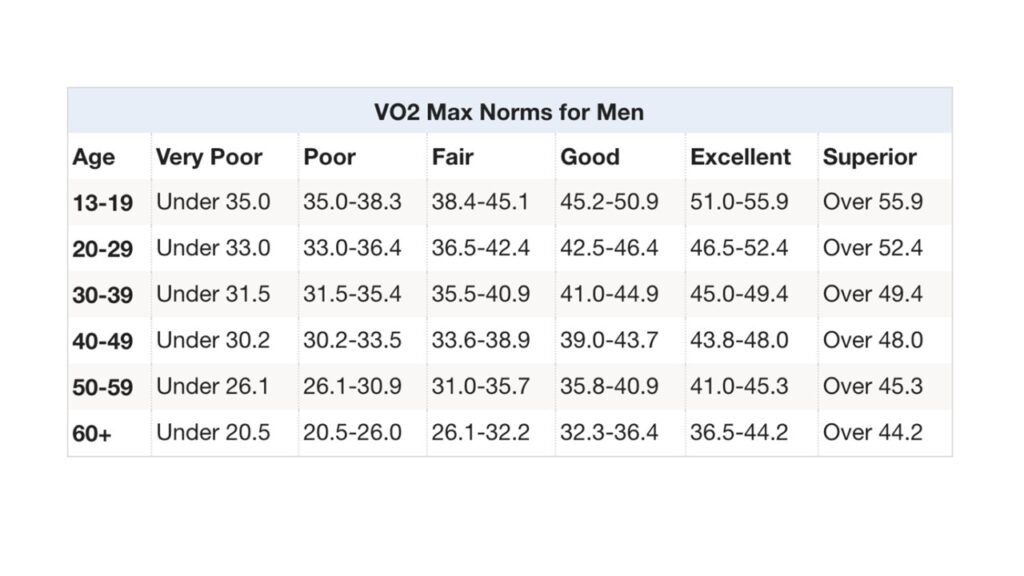Using the 20m Shuttle Run to Test Fitness

The 20m shuttle run, also known as the beep test, is validated and reliable test which is predictive of the maximal rate of oxygen consumption (VO2max), and is considered as a gold standard field test for the measurement of aerobic fitness (1,2). A VO2max test can cost upwards of $150-250 in most Canadian cities, and will set you back an hour of laboratory time, the beep test was developed to be used as a convenient field-based physiological testing alternative.
Paliczka et al. (3) reasoned that the 20m Shuttle Run test is an ideal field test because judgment about pace is eliminated by using audio signals, the incremental test ensures a gradual rise in work rate and heart rate, the test is highly reliable (r = 0.975), and large numbers of participants can be tested at a time. Furthermore, individuals looking to get a snapshot of where their fitness is at can use this test with very little equipment and set up and they can perform it on their own.
I’ve used the beep test for over a decade with a range of athletes and general population clients to get an idea of their cardiovascular fitness. The beep test is great because as long as you have a 20m space, the recording, and some grit, you too can determine your fitness within 20 minutes.
This test is maximal, so be sure to check with a doctor or Certified Exercise Physiologist to ensure you’re healthy enough to do the test!
What do I need to get started?
Equipment Needed: minimum 2 cones for 1 person, 4 cones for 2 people, tape measure, stereo and shuttle run CD (or the YouTube recording included below)
Set-Up: Measure a 20 m distance and place cones at either end of a 20m gym or marked-off space.
Data to Record: last stage completed before stopping.
Instructions for the test:
- Do a thorough warm up before you begin.
- You will need at least 20m of space where you can run out 20m and back 20m along the same line. This makes this test feasible to include in Physical Education classes, field testing, and “fun” workouts.
- Make sure to tie your laces with double knots, tight, and have on running shoes instead of casual sneakers. Because of the repeated and eventual high-intensity cuts you will have to perform with this test, having a shoe with extra pronation support or ankle support might be a good idea. Don’t wear casual Nike-free’s or the like, as I’ve seen too many athletes roll their ankles in those shoes during this test.
- Download the recording of the 20m Shuttle Run. Below I’ve attached the Australian Beep Test version (there is also a Canadian version, called the Leger 20m shuttle run), as this is the version that I have used most extensively with my clientele.
- Ensure that your device will not have any interruptions during the playing of the recording. If you are using your smartphone, turn your phone on airplane mode if you cannot download the recording so that you don’t have any interruptions during the test (keep your wifi on if that’s how you’re accessing the test!)
- Participants are instructed to run between the two 20m lines with a pivot between the lines. You do not have to run past the line before you turn around, rather you can pivot and run within the two lines. Do not leave the line before the beep.
Termination Criteria
a) Failure to make it to the line on a BEEP twice in a row.
b) Failure to wait at line until BEEP sounds twice in a row.
click HERE for the recording
How did I do on the test?
Use the following table I created to find your maximal aerobic speed (MAS) from the highest level you attained on the test (Table 1).

Then, use your MAS to calculate your predicted VO2max. There are a few different equations published for use, so feel free to use more than one to get a range of a likely VO2max score (5).
(Equation 1) Predicted VO2 max = –24.4 + 6.0 MAS
(Equation 2) Predicted VO2max = –27.4 + 6.0 MAS
(Equation 3) Predicted VO2max = –35.8 + 6.55 MAS
Is that a good score?
Check how your fitness stacks up using the tables below:


Should I care about my score?
If you’ve made it this far in the article, something tells us you have a desire to figure out your level of fitness! Perhaps you are an athlete who is about to enter college sports and want to ensure you’re prepared for testing if they use this one in their battery of tests, or perhaps you’ve been training hard all summer to improve a score you tested yourself on in the past. Even if you’re not an athlete training for anything in particular, we know that physical activity can be recommended as a preventive therapy to people of all ages.
Further, for athletes who compete in “mixed sports”, or ones that require some strength and some aerobic components alike, fitness testing is standard on many teams. So, get ahead by practicing the Beep Test a few times per year, and see if your score is improving towards the Superior category!
If you’ve completed the testing, and would like to improve your score but don’t know where to start, please feel free to reach out to me, or browse through many of the other CSCA resources to help.

Carla is the owner of Vital Strength and Physiology, where she works full time on growing the business in Calgary, Alberta. With a Master’s of Kinesiology from the UofC, and as a CSEP-CEP High Performance Specialist, Carla’s passion is in tackling a range of clients from National level athletes to chronic pain and clinical cases. She is often referred clients by top level therapists who recognize that treatments alone are not enough to solve movement issues that arise from poor movement patterns in the first place. As she goes into her 5th year as the Strength and Conditioning Coach with UofC’s Dinos Women’s Hockey team, and continues to write for CSCA, she keeps herself very busy!
click HERE for more information about Carla and her company
References and Resources
- Léger L, Gadoury C. (1989) Validity of the 20 m shuttle run test with 1 min stages to predict VO2max in adults. Canadian Journal of Sport Sciences. 14(1):21-26.
- Léger, L., Mercier, D., Gadoury, C., Lambert, L. (1988) The multistage 20 metre shuttle run test for aerobic fitness, Journal of Sports Sciences, 6:2, 93-101, DOI: 10.1080/02640418808729800
- Paliczka, V. J., Nichols, A. K., & Boreham, C. A. (1987). A multi-stage shuttle run as a predictor of running performance and maximal oxygen uptake in adults. British Journal of Sports Medicine, 21(4), 163–165. https://doi.org/10.1136/bjsm.21.4.163
- Quinn, E. (2021, August 3). VO2 Max Testing in Athletes. Measuring Cardio Fitness and Endurance Capacity. VeryWellFit. https://www.verywellfit.com/what-is-vo2-max-3120097
- Stickland, M. K., Petesen, S. R., Bouffard, M. (2003) Prediction of maximal aerobic power from the 20-m multi-stage shuttle run test. Canadian Journal of Applied Physiology. 28(2) 272-282.






